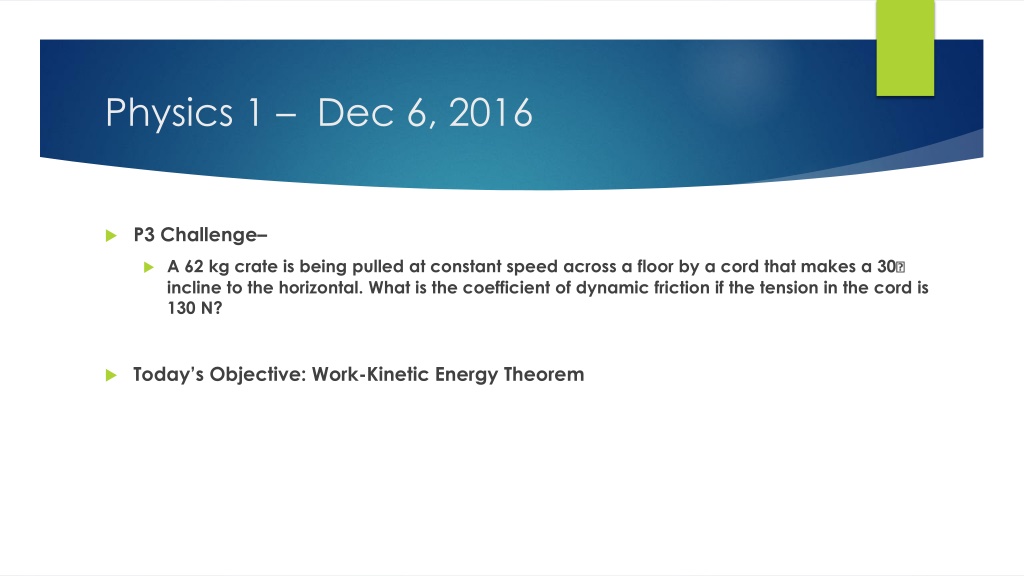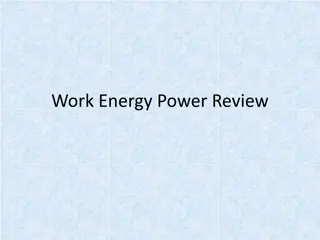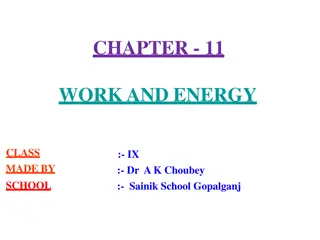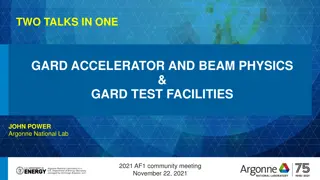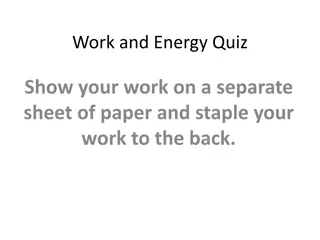Understanding Work and Energy in Physics
This content covers the concept of work defined as the product of a force through a distance, positive and negative work scenarios, when work is not done, work at an angle, and work by a variable force. It also includes practice problems to enhance comprehension on the topic of work and energy in Physics.
Uploaded on Oct 08, 2024 | 0 Views
Download Presentation

Please find below an Image/Link to download the presentation.
The content on the website is provided AS IS for your information and personal use only. It may not be sold, licensed, or shared on other websites without obtaining consent from the author. Download presentation by click this link. If you encounter any issues during the download, it is possible that the publisher has removed the file from their server.
E N D
Presentation Transcript
Physics 1 Dec 6, 2016 P3 Challenge A 62 kg crate is being pulled at constant speed across a floor by a cord that makes a 30 incline to the horizontal. What is the coefficient of dynamic friction if the tension in the cord is 130 N? Today s Objective: Work-Kinetic Energy Theorem
Agenda, Assignment IB 2.3 Work, Energy and Power Agenda Work Work Kinetic Energy Positive/Negative Work Work-kinetic energy theorem Zero work Assignment: Kinetic Energy Work-kinetic energy theorem Work Kinetic Energy Theorem Worksheet
Physics Work defined Work is the product of a force through a distance. Positive work When the force and the displacement are in the same direction Adds to the energy of a system. Negative work When the force and the displacement are in opposite directions Removes energy from a system Note: friction always does negative work.
When is work NOT done? A perpendicular force does no work. Force applied without any change in position does no work.
Work at an angle general case Forces in the same or opposite direction do maximum work. Forces at an angle only the component of the force in the direction of the displacement does work. IB equation: ? = ??cos cos? in data booklet Image result for Image of work done by force at an angle s may be written as x, y, r or d. W = F d (vector dot product)
Work by a variable force If a force is not constant over the distance, then you can plot how the force varies as a function of position. Still a force times a distance. The work done by the force over a distance is represented by the area between the graph and the x-axis on this graph. Ex: Work done by a spring force: W = kx2
Practice Problems A worker pulls a cart with a 45 N force at an angle of 25 to the horizontal over a distance of 1.2 m. What work does the worker do on the cart? A 900N mountain climber scales a 100m cliff. How much work is done by the mountain climber? Angela uses a force of 25 Newtons to lift her grocery bag while doing 50 Joules of work. How far did she lift the grocery bags?
Energy What is energy? The ability to do work. Comes in two varieties: EK= kinetic energy Types of kinetic energy: motion, light, sound, thermal energy, electrical energy (all are a type of motion) Types of potential energy: gravitational, chemical, nuclear, spring, electrical potential (all are reversibly stored energy) Ep= potential energy
Kinetic Energy Kinetic energy energy of motion Anything that is moving has kinetic energy EK= mv2 (in data booklet) Ex: What is the Kinetic Energy of a 150 kg object that is moving with a speed of 15 m/s? Ex: An object has a kinetic energy of 25 J and a mass of 34 kg , how fast is the object moving? Ex: An object moving with a speed of 35 m/s and has a kinetic energy of 1500 J, what is the mass of the object?
Work K.E. Theorem a. The distance the helicopter traveled? The net work done on an object is equal to the change in kinetic energy for that object. b. The work done by the lifting force? c. The work done by the gravitational force? Wnet= K.E = mv2 mu2 not in data booklet, need to know conceptually. d. The net work done on the helicopter? e. The final kinetic energy of the helicopter? Ex: A 500. kg light-weight helicopter ascends from the ground with an acceleration of 2.00 m/s2. Over a 5.00 sec interval, what is f. The final velocity of the helicopter? g. Verify this value using kinematics.
Exit Slip - Assignment Exit Slip- How much work is done by gravity as you carry a 65 N backpack up a flight of stairs to landing 1.3 m higher than the previous floor? What s Due on Dec 8? (Pending assignments to complete.) Work and Kinetic Energy Worksheet What s Next? (How to prepare for the next day) Read 2.3 p78-95 about Work and Energy
